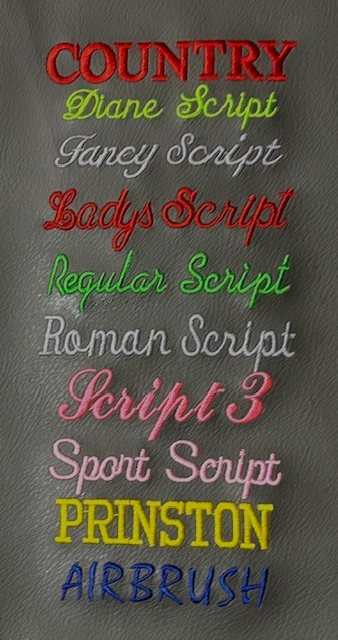Trendy Backpack Embroidery for Personalized and Unique Styles
Trendy Backpack Embroidery for Personalized and Unique Styles
Blog Article
The Art of Customized Needlework: Opening the Secrets to Creating One-of-a-kind and Unforgettable Designs
Needlework, a craft soaked in tradition and creativity, holds within its detailed stitches the power to transform material right into a canvas of unique expression. The tricks to developing customized needlework designs that astound the eye and leave a long-term impression depend on a fragile equilibrium of technique, creativity, and interest to information. As we dive into the globe of custom-made embroidery, we uncover the nuanced interaction between string selection, stitch intricacy, and layout customization that elevates a mere garment to an artwork. Join us on a journey via the art of custom needlework as we decipher the secrets behind crafting genuinely remarkable and distinctive creations.
Selecting the Right Needlework Threads
When selecting embroidery strings, what vital aspects should you think about to make certain the most effective results for your custom-made styles? The choice of embroidery string is critical in establishing the last result of your embroidered layout. Among the main considerations is the product of the string. Different materials such as cotton, polyester, rayon, and silk supply varying degrees of sheen, sturdiness, and structure. It is essential to choose a string material that matches the textile you are embroidering on and aligns with the wanted look of the design.
Additionally, the weight or density of the string plays a significant function in the look of the embroidery. Thicker threads can include dimension and appearance to your design, while finer threads are perfect for complex information and small message. Additionally, thinking about the shade fastness and washability of the string is crucial to guarantee that your personalized designs keep their top quality and vibrancy with time. By carefully assessing these variables and selecting top notch strings that satisfy your specific requirements, you can boost the visual allure and durability of your stitched creations.
Discovering Different Stitch Techniques
To delve right into the world of 'Discovering Various Stitch Methods', one must realize the ins and outs and subtleties that each sewing approach offers the art of embroidery. Different stitch techniques not only add visual rate of interest but additionally add to the overall appearance and dimension of the layout. One prominent stitch technique is the satin stitch, which entails carefully packed parallel stitches to develop a smooth and shiny surface, perfect for completing forms and producing vibrant details.
On the other hand, the backstitch is a functional method commonly made use of for outlining and adding fine information. It entails stitching in reverse to produce a strong line of embroidery. In addition, the French knot stitch adds a responsive element to styles, excellent for producing distinctive accents like flower centers or attractive touches.
Checking out various stitch techniques enables embroiderers to have fun with light, shadow, and deepness within their styles, elevating the aesthetic allure and creative quality of their needlework jobs. By mastering various sewing techniques, one can unlock countless possibilities for creating one-of-a-kind and unforgettable custom needlework pieces.
Incorporating Personalized Design Aspects
Having actually explored the intricacies of various stitch methods such as the satin stitch, backstitch, and French knot, the emphasis currently shifts in the direction of incorporating individualized design components in customized needlework jobs. Personalized design components play a critical role in making embroidery jobs absolutely unique and unforgettable.
An additional means to incorporate customized layout components is by including symbols or themes that hold special significance to the recipient or mirror their passions and personality. Integrating a favorite flower, animal, or hobby-related sign can make the embroidery style a lot more significant and individualized. In addition, picking shades that resonate with the recipient or line up with the desired motif can additionally improve the personalization of the embroidery project.
Mastering the Art of Color Coordination
One key aspect of color sychronisation is understanding color theory. This includes understanding how different colors communicate with each other, the feelings they communicate, and just how they can be incorporated to develop aesthetically enticing designs. By applying color concept concepts, embroiderers can produce unified color palettes that enhance the overall look of the go to these guys design.
Additionally, taking note of contrast is essential in color coordination. Using contrasting shades can assist specific aspects of the style pop, enhance clarity, and produce a visually dynamic embroidery item. By understanding the art of shade sychronisation, embroiderers can boost their styles and produce remarkable items that reverberate with customers and audiences alike.
Enhancing Texture With Advanced Embroidery Stitches

French knots, for instance, are ideal for adding small, raised dots to your style, simulating the appearance of grains or producing a textured surface. Bullion knots, on the other hand, can be used to create twisted, ropelike elements that add an elegant feel to the needlework. Seed sewing includes small, scattered stitches that can fill read here up in areas with a multicolor texture, while turkey job creates fluffy, dimensional accents evocative animal fur or vegetation. Trying out these sophisticated embroidery stitches allows you to press the borders of standard embroidery and create absolutely one-of-a-kind and aesthetically appealing textures in your layouts.
Verdict
To conclude, the art of custom needlework involves a mix of selecting the right strings, exploring different stitch techniques, integrating individualized style aspects, grasping shade control, and enhancing appearance with innovative stitches. By comprehending and applying these essential components, embroiderers can produce one-of-a-kind and memorable you can try here designs that showcase their creativity and ability. Needlework fanatics can open the keys to creating lovely and bespoke pieces that attract attention and leave a lasting perception.
Report this page